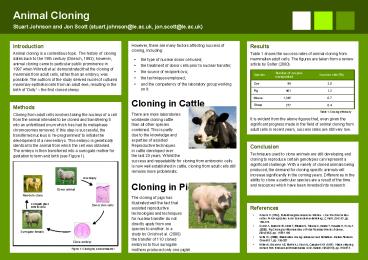Animal Cloning - PowerPoint PPT Presentation
1 / 1
Title:
Animal Cloning
Description:
Animal cloning is a contentious topic. ... The authors of the study derived nuclei of cultured mammary epithelial cells ... Whilst the ... – PowerPoint PPT presentation
Number of Views:562
Avg rating:3.0/5.0
Title: Animal Cloning
1
Animal Cloning Stuart Johnson and Jon Scott
(stuart.johnson_at_le.ac.uk, jon.scott_at_le.ac.uk)
Introduction Animal cloning is a contentious
topic. The history of cloning dates back to the
19th century (Driesch, 1892) however, animal
cloning came to particular public prominence in
1997 when Wilmutt et al. demonstrated that the
cloning of mammals from adult cells, rather than
an embryo, was possible. The authors of the study
derived nuclei of cultured mammary epithelial
cells from an adult ewe, resulting in the birth
of Dolly the first cloned sheep.
However, there are many factors affecting success
of cloning, including
Results Table 1 shows the success rates of animal
cloning from mammalian adult cells. The figures
are taken from a review article by Solter (2000).
- the type of nuclear donor cell used
- the treatment of donor cells prior to nuclear
transfer - the source of recipient ova
- the techniques employed
- and the competency of the laboratory group
working on it.
Cloning in Cattle There are more laboratories
worldwide cloning cattle than all other species
combined. This is partly due to the knowledge
and expertise of assisted Reproductive
techniques in cattle developed over the last 20
years. Whilst the success and repeatability for
cloning from embryonic cells is now well
established in cattle, cloning from adult cells
still remains more problematic. Cloning in
Pigs The cloning of pigs has illustrated well
the fact that assisted reproductive
technologies and techniques for nuclear
transfer do not directly apply from one species
to another. In a study by Onishi et al. (2000)
the transfer of 110 cloned embryos to four
surrogate mothers produced only one piglet.
Methods Cloning from adult cells involves taking
the nucleus of a cell from the animal intended to
be cloned and transferring it into an
unfertilised ovum which has had its metaphase
chromosomes removed. If this step is successful,
the transferred nucleus is re-programmed to
initiate the development of a new embryo. This
embryo is genetically identical to the animal
from which the cell was obtained. The embryo is
then transferred into a surrogate mother for
gestation to term and birth (see Figure 1).
It is evident from the above figures that, even
given the significant progress made in the field
of animal cloning from adult cells in recent
years, success rates are still very low.
Conclusion Techniques used to clone animals are
still developing and cloning to reproduce certain
genotypes can represent a significant challenge.
With a variety of cloned animals being produced,
the demand for cloning specific animals will
increase significantly in the coming years.
Differences in the ability to clone a particular
species are a result of the time and resources
which have been invested into research.
skin biopsy
Donor animal
Newborn clone
surrogate gives birth to clone
Donor skin cells
References
nuclear transfer to produce embryo
- Driesch H (1892), Entwicklungsmechanische
Studien. I. Der Wert der beiden ersten
Furchungszellen in der Echinodermentwicklung. Z.
Wiss. Zool. 53, pp. 160-178. - Onishi A, Iwamoto M, Akita T, Mikawa S, Takeda K,
Awata T, Hanada H, Perry A (2000). Pig Cloning by
Microinjection of Fetal Fibroblast Nuclei.
Science, 289(5482), pp. 1188-1190 - Solter D, (2000). Mammalian cloning advances and
limitations. Nature Reviews Genetics 1, pp.
199-207 - Wilmut I, Schnieke AE, McWhir J, Kind AJ,
Campbell KH (1997). Viable offspring derived from
fetal and adult mammalian cells. Nature,
385(6619), pp. 810-813.
surrogate gives birth to clone
transfer embryo into surrogate female/mother
Surrogate female
Clone embryo
Figure 1 Cloning by nuclear transfer































